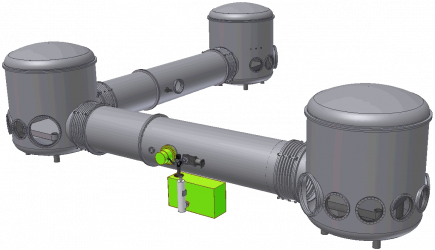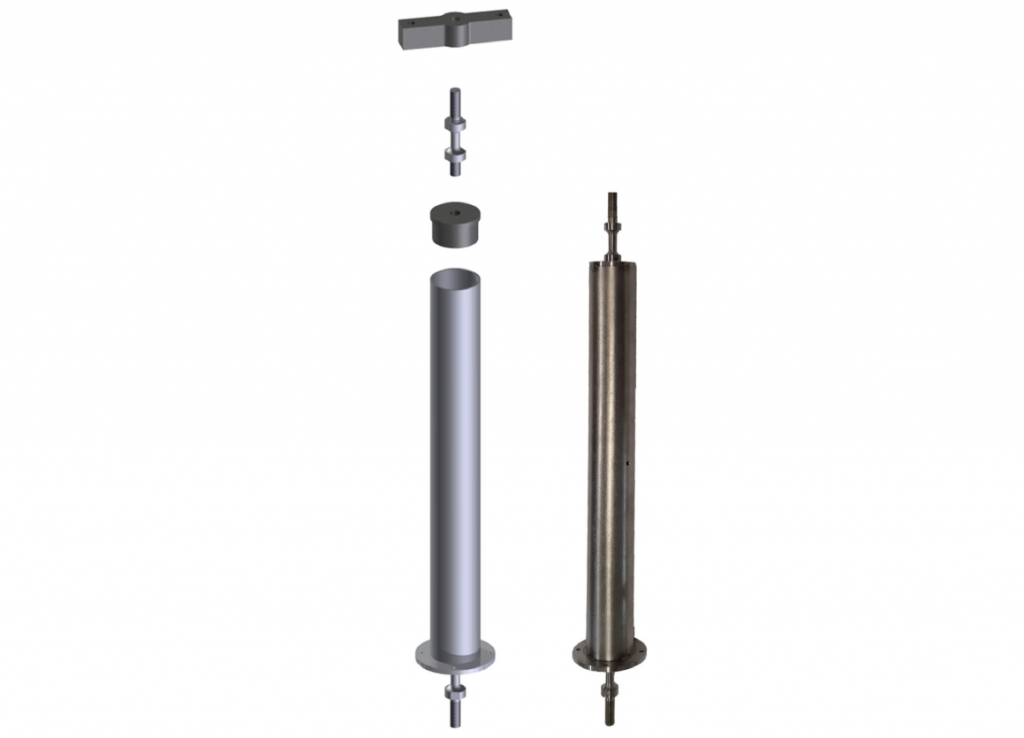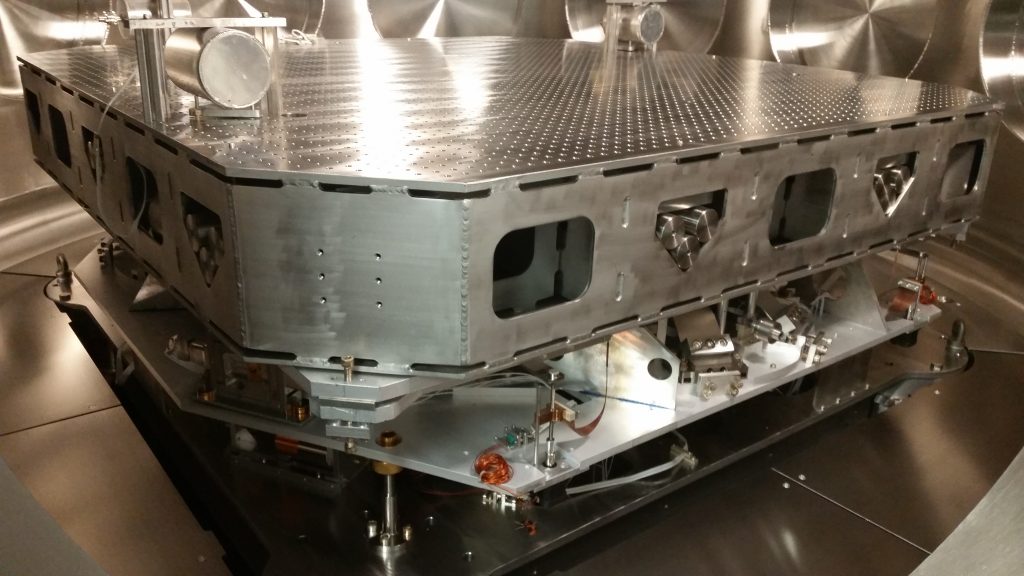
The optical tables are the mechanical interface between the vacuum system and the multiple stage pendulum suspension systems. The latter are used to suspend main and ancillary optics of the interferometer. Each table is supported by a Seismic Attenuation System (SAS) which acts as a pre-isolation stage for the suspended optics. The SAS is a six degrees-of-freedom vibration isolator providing the necessary shielding from the ground motion. Microseismic noise is the main environmental source of disturbance for the experiments in the frequency range from 0.1 to 100 Hz. Attenuation factors larger than 70 dB at 10 Hz are achieved in vertical and the horizontal direction along the main axis of the interferometer.
Why is seismic pre-isolation required?
The Earth’s crust moves randomly and continuously with amplitudes often exceeding the micron level. The broadband spectrum of Earth’s motion is dominated at low frequencies (below 0.3 Hz) by the “sound” of the ocean’s swell (the so-called microseismic peak). A high seismic noise level characterises the frequency region of 1 to 10 Hz in urbanised areas as a result of human activities. Our facility is located in central Hannover surrounded by roads and tramways. Vertical and horizontal displacements up to 300 nm root mean square above 1 Hz can be measured with a seismometer on the lab floor during daytime.
The triple suspensions are very effective at filtering ground motion to the suspended optic in our measurements band (> 50 Hz). However, the optics suspensions have their resonances in the frequency range of the seismic spectrum. Therefore, the amplitude of the optical tables’ motion has to be reduced in order to avoid noise injection and limitation of the achievable sensitivity. Similar to the suspended optics, seismic attenuation of the tables is obtained passively using mechanical oscillators as second-order low pass filters above their resonance frequencies. Additionally, various sensors and actuators provide active damping and inertial isolation. The tables have low natural frequencies, 0.1 Hz in the horizontal and 0.3 Hz in the vertical direction. With this, large vibration suppression ratios of 40-50 dB at 3 Hz are achieved in both directions.
Working principle of the AEI-SAS
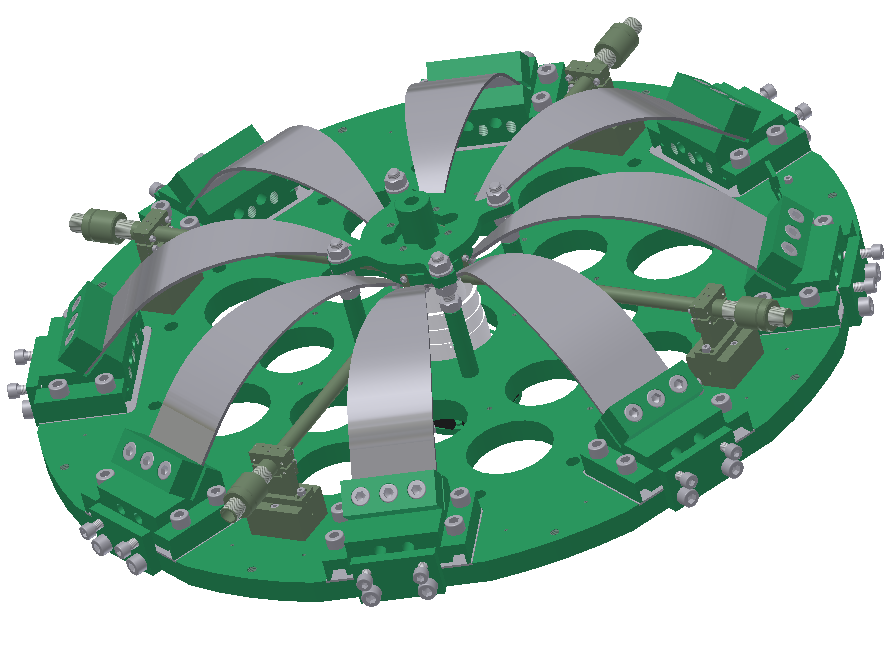
Vertical passive isolation
The optical table sits on three vertical vibration isolators filters providing mechanical compliance along the vertical, pitch and roll degrees of freedom. Each filter is a tunable spring made by a crown of curved cantilever blades compressed each against the other: the constrained radial stress creates a geometric anti-spring (GAS) effect that leads to a low stiffness in the vertical direction at the nominal load. Each set of compressed blades is referred to as a GAS filter (GAS is an acronym, no gas is actually used). We tune the natural frequencies of each filter down to 0.3 Hz by mechanical adjustment of the compression rate. The inertia of the blades limits the minimum vibration transmissibility to -60 dB, which can be improved up to -80 dB by using the built-in compensators (so-called ‘magic wands’).
Horizontal passive isolation
The three GAS filters are mounted on a rigid plate supported by three inverted pendulum (IP) legs: very low natural frequencies (around 0.1 Hz) are achieved for the horizontal translational modes and for the yaw mode. This is done by adjusting the IP bottom flexures to compensate for the load gravitational torque which leads to instability. The IP top short flexure hinges allow the filter plate to wobble in the horizontal plane preventing its pitch/roll movement. The inertia of the legs limits the IP minimum vibration transmissibility to -70 dB which can be improved to up to -90 dB by tuning the built-in counterweights.
Active Isolation
The passive isolation discussed above is effective at attenuating vibrations with frequencies above a few Hz. A trade off for this good higher frequency performance is the strong enhancement of ground motion at the resonance frequencies of the system. The low frequency performance can be significantly improved using active control loops. Detailed information about the active isolation, the sensors and actuators is provided in “Local active isolation of the AEI-SAS for the AEI 10 m prototype facility”.
Sensors
A variety of sensors are used to measure the local motion of each AEI-SAS.
Linear Variable Differential Transformers (LVDTs): These are relative sensors used to measure the motion of the AEI-SAS with respect to the ground motion for every degree of freedom.
Accelerometers: Custom built Watt’s linkage accelerometers are used to measure the horizontal inertial motion of the AEI-SAS.
Geophones: Commercial geophones are used to measure the inertial motion of the AEI-SAS. These are oriented for both horizontal and vertical sensitivity.
Optical levers: Laser beams are directed from one AEI-SAS to another where displacement of the beam in the horizontal and vertical directions can be read out. Due to the 10 m lever arm, the displacement is extremely sensitive to rotation and tilt of the table from which the beam is sent from.
Suspension Platform Interferometer: Heterodyne Mach-Zehnder interferometers with a phasemeter readout are used to measure the distances between two tables. Further details are provided on the webpages of the SPI.
Actuators
Voice-coil actuators: Voice-coils and magnets are used for actuation on the AEI-SAS. A current is sent to the coils which are rigidly connected to the ground. A magnetic field is generated which pushes or pulls on a magnetised part of the AEI-SAS.
Motorised springs: Due to the limited range of the voice-coil actuators, the AEI-SAS is also equipped with springs (soft steel blade springs) which can be moved via stepper motors. This enables the AEI-SAS to be moved to a position within the range of the voice-coil actuators. The motors are subsequently switched off afterwards due to their high noise, and are not used in any of the control loops.
Performance:
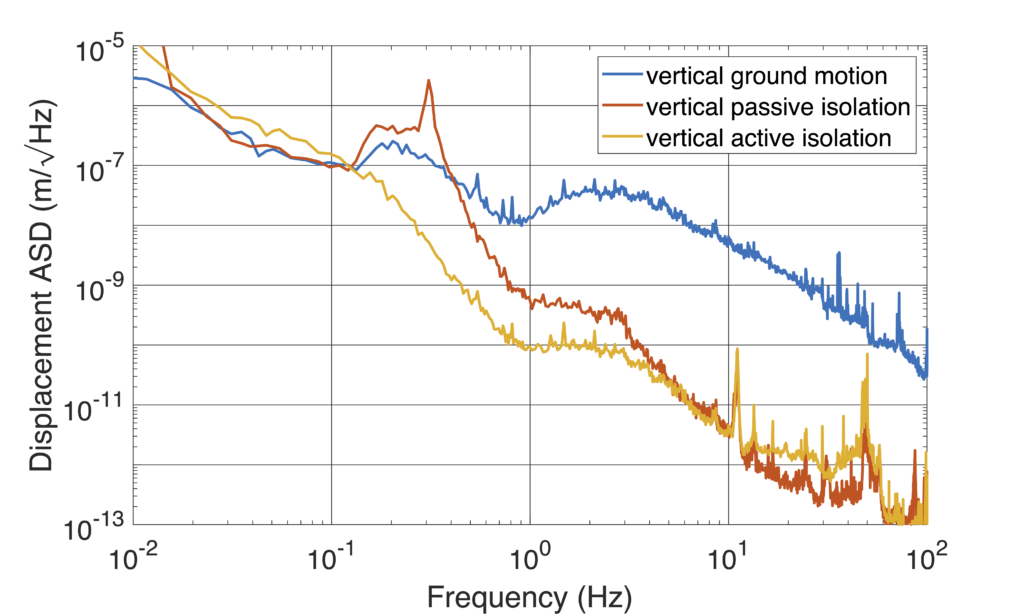
This plot shows the suppression of ground motion via the AEI-SAS located in the west vacuum tank. The plot only shows the motion of the table in the vertical translation degree of freedom and was measured using witness (out-of-loop) geophones. The passive performance is shown in red, with ground motion being suppressed above approximately 0.5 Hz, but enhanced at the natural resonance frequency of the GAS filters at 0.3 Hz. Low frequency suppression is improved via active control including the suppression of the resonance. Further results can be found in a paper about active isolation and in G. Bergmann PhD thesis.
Besides the local seismic isolation with the performance shown in the diagram, there is the global isolation, focussing on the stabilization of inter-table motion. Global seismic isolation is implemented in the AEI 10 m prototype in a worldwide unique realization and is based on the Suspension Platform Interferometer and optical levers. It is subject of current investigations by the prototype group and serves as a demonstrator for possible implementation in current and future gravitational wave detectors.
References
R. Kirchhoff et al., ‘Local active isolation of the AEI-SAS for the AEI 10 m prototype facility’. Classical and Quantum Gravity, Volume 37(11), (2020). DOI: https://doi.org/10.1088/1361-6382/ab857e
G. Bergmann, ‘Improving the seismic isolation for the AEI 10 m prototype’ PhD thesis, Gottfried Wilhelm Leibniz Universität, Hannover, (2018). DOI: https://doi.org/10.15488/3329
G. Bergmann et al., ‘Passive-Performance, Analysis, and Upgrades of a 1-Ton Seismic Attenuation System’, Classical and Quantum Gravity 34(6), (2017). DOI: https://doi.org/10.1088/1361-6382/aa5e1f
R. Kirchhoff et al.,’Huddle test measurement of a near Johnson noise limited geophone’, Review of Scientific Instruments 88, 115008 (2017). DOI: https://doi.org/10.1063/1.5000592
A. Wanner, ‘Seismic Attenuation System (AEI-SAS) for the AEI 10 m Prototype’, PhD thesis, Gottfried Wilhelm Leibniz Universität, Hannover, (2013). DOI: https://doi.org/10.15488/8194
A. Stochino et al., ‘The Seismic Attenuation System (SAS) for the Advanced LIGO gravitational wave interferometric detectors’, Nuclear Instruments and Methods in Physics Research Section A, 598(3), pp.737-753, (2009). DOI: https://doi.org/10.1016/j.nima.2008.10.023
A. Takamori et al., ‘Inverted pendulum as low-frequency pre-isolation for advanced gravitational wave detectors’, Nuclear Instruments and Methods in Physics Research Section A, 582(2), pp.683-692, (2007). DOI: https://doi.org/10.1016/j.nima.2007.08.161
A. Bertolini et al., ‘Seismic noise filters, vertical resonance frequency reduction with geometric anti-springs: a feasibility study’, NIM A,vol. 435, pp.475-483 (1999). DOI: https://doi.org/10.1016/S0168-9002(99)00554-9
